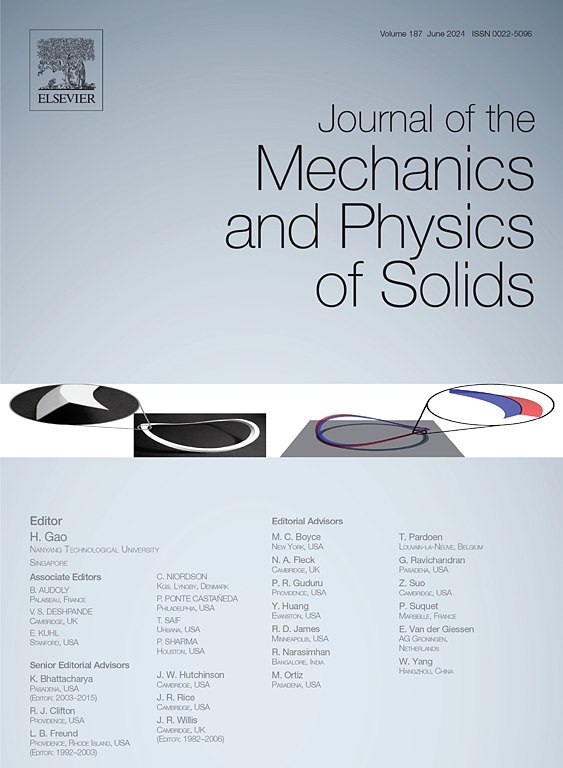Thermo-chemo-mechanical model and variational multiscale framework for material and geometric evolution in frontal polymerization
IF 5
2区 工程技术
Q2 MATERIALS SCIENCE, MULTIDISCIPLINARY
引用次数: 0
Abstract
This paper presents a thermodynamically consistent model for thermo-chemo-mechanical processes in frontal polymerization (FP). The model consists of cure kinetics, heat transfer, and finite strain kinematics of nonlinear inelastic solid undergoing finite deformation. The constitutive relations are derived by enforcing non-negative entropy production which implies the existence of cure induced inelastic processes during material property evolution. Rapid curing triggered by thermo-chemical processes results in traveling reaction fronts that traverse the domain, and material properties evolve across these fronts on short time scales, accompanied with chemical expansion/contraction of the constituents. Complexity of the process increases with increased rate of chemical reaction, increased rate of mass transport, and large mechanical deformations. Evolving nonlinearities and coupled thermo-chemo-mechanical effects give rise to spatially localized phenomena that exhibit shear bands, steep gradients, and boundary and/or internal layers. The presence of interfacial effects can also trigger jumps in the fields, leading to further classification as mathematically non-smooth mixed-field problems. These modeling issues require mathematical formulations that can handle rapidly evolving material nonlinearity as well as steep traveling gradients. A stabilized finite element method that is based on the Variational Multiscale (VMS) framework is employed. A unique attribute of the VMS framework is the derivation of the residual-based fine-scale models that represent subgrid scale physics. These models enhance the stability of the numerical method as well as the accuracy of the computed physics. Several test cases are presented that investigate the mathematical attributes of the constitutive model for FP, and the role of enhanced stability and higher spatial accuracy of the proposed stabilized method in free-form printing with evolving polymerization front.
正面聚合中材料和几何演化的热-化学-力学模型和变分多尺度框架
本文提出了正面聚合(FP)中热化学机械过程的热力学一致性模型。该模型由非线性非弹性固体在有限变形时的固化动力学、传热和有限应变运动学组成。本构关系是通过强制非负熵产生推导出来的,这意味着在材料性能演化过程中存在固化诱导的非弹性过程。由热化学过程引发的快速固化导致了穿越区域的移动反应前沿,材料性质在短时间尺度上跨越这些前沿演变,伴随着成分的化学膨胀/收缩。过程的复杂性随着化学反应速率的增加、质量传递速率的增加和大的机械变形而增加。不断演变的非线性和耦合的热-化学-机械效应产生了空间局部现象,表现为剪切带、陡峭梯度、边界和/或内层。界面效应的存在也可以触发场的跳跃,导致进一步分类为数学上的非光滑混合场问题。这些建模问题需要能够处理快速发展的材料非线性以及陡峭的行进梯度的数学公式。采用了一种基于变分多尺度框架的稳定有限元方法。VMS框架的一个独特属性是派生了基于残差的细尺度模型,该模型表示子网格尺度物理。这些模型提高了数值计算方法的稳定性和计算结果的准确性。提出了几个测试用例来研究FP本构模型的数学属性,以及所提出的稳定方法在具有进化聚合前沿的自由形状打印中增强稳定性和更高空间精度的作用。
本文章由计算机程序翻译,如有差异,请以英文原文为准。
求助全文
约1分钟内获得全文
求助全文
来源期刊
CiteScore
9.80
自引率
9.40%
发文量
276
审稿时长
52 days
期刊介绍:
The aim of Journal of The Mechanics and Physics of Solids is to publish research of the highest quality and of lasting significance on the mechanics of solids. The scope is broad, from fundamental concepts in mechanics to the analysis of novel phenomena and applications. Solids are interpreted broadly to include both hard and soft materials as well as natural and synthetic structures. The approach can be theoretical, experimental or computational.This research activity sits within engineering science and the allied areas of applied mathematics, materials science, bio-mechanics, applied physics, and geophysics.
The Journal was founded in 1952 by Rodney Hill, who was its Editor-in-Chief until 1968. The topics of interest to the Journal evolve with developments in the subject but its basic ethos remains the same: to publish research of the highest quality relating to the mechanics of solids. Thus, emphasis is placed on the development of fundamental concepts of mechanics and novel applications of these concepts based on theoretical, experimental or computational approaches, drawing upon the various branches of engineering science and the allied areas within applied mathematics, materials science, structural engineering, applied physics, and geophysics.
The main purpose of the Journal is to foster scientific understanding of the processes of deformation and mechanical failure of all solid materials, both technological and natural, and the connections between these processes and their underlying physical mechanisms. In this sense, the content of the Journal should reflect the current state of the discipline in analysis, experimental observation, and numerical simulation. In the interest of achieving this goal, authors are encouraged to consider the significance of their contributions for the field of mechanics and the implications of their results, in addition to describing the details of their work.

 求助内容:
求助内容: 应助结果提醒方式:
应助结果提醒方式:


